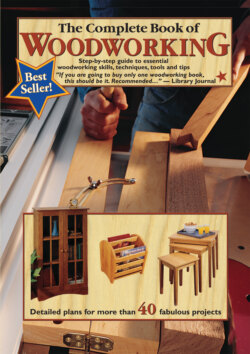Читать книгу Draw Manga - Tom Carpenter - Страница 20
На сайте Литреса книга снята с продажи.
Defining Hardwoods & Softwoods
ОглавлениеBotanically speaking, trees are categorized as either hardwoods or softwoods. Here’s a simple way to distinguish the two: hardwoods are deciduous (broad leafed), generally losing their leaves in late fall and reproducing with flowers and fruits or nuts. Softwoods, on the other hand, are coniferous; they retain their needle-shaped leaves in the winter and reproduce by spreading their seed through open cones. The terms ‘softwood’ or ‘hardwood’ have nothing to do with whether the wood is physically hard or soft.
All trees have two growth spurts each year. Their spring growth produces a light-colored material between the rings, called earlywood. The more dense cells produced in the late summer and fall are known as latewood, and these constitute the darker rings that every child has counted to determine a tree’s age.
Softwood trees tend to grow more rapidly than hardwoods, and they have wider bands of earlywood than most slow-growing hardwoods. Softwood trees also have larger, less dense cells in the earlywood than hardwoods. This helps explain why a nail can be driven into a wide-celled pine board more easily than a tight-grained oak board; the cell structure is less dense, allowing easier penetration.
Another property worth noting is that hardwood trees allow their branches time and space to grow in almost any direction, in order to maximize leaf exposure to sunlight. The internal stresses present in the wood, resulting from the weight of these outspread branches, create interesting figure and grain patterns in the wood (See below). However, there is a price to pay for that beauty: highly figured wood tends to distort more readily than straight-grained boards as the stresses are released.
HARDWOOD VS. SOFTWOOD
Despite what the categories imply, the distintion between hardwoods and softwoods has to do with leaf type and is not a measure of wood hardness. Oak, a common hardwood, has broad leaves that shed in the fall, while pine, a coniferous softwood, retains its needles all winter.
COLOR, FIGURE & GRAIN PATTERN
Part of the attraction of woodworking comes from the opportunity to work with wood displaying dramatic differences in color, figure and grain pattern. Wood color is a product of of how its tannins, gums and resins react to exposure to the air. Often, wood will continue to darken and change color over time, developing a rich patina. Figure—the surface pattern on a board—can be the result of numerous natural causes ranging from drought or freezing to prevailing winds, disease, age or insect damage. Grain display is dependent on the direction and regularity of the wood fibers relative to the center of the trunk as well as how the lumber is cut from the tree.
Three centuries ago, colonial woodworkers cut their lumber from vast tracts of virgin coniferous forest. It wasn’t uncommon for them to glean white pine boards measuring 2, 3 and even 4 ft. wide, with no knots or other disfigurement. It’s no surprise that much of their early furniture was built from softwood. Boards culled from today’s replanted pine forests, on the other hand, have knots every 12 to 18 in. along their length (one year’s growth). Because of their minimal girth at harvest, boards often contain considerable sapwood as well.
The best uses for today’s softwoods are in applications where straight, abundant, less expensive lumber is needed. Mills cut softwoods largely into construction lumber for framing walls, floors and roofs or process it into plywood, chipboard and oriented strandboard to sheathe buildings. Of course, a percentage of this lumber also is headed for woodworkers, but premium-grade softwoods can command prices that compete with hardwoods.
Hardwoods, on the other hand, are most often sturdier, heavier, more figured and show a great variety of colors. So, it’s no surprise that the more attractive, yet less available hardwoods are more costly and are the natural choice for furnituremaking, cabinetry and trim work. It also explains why hardwoods are not available in the same nominal dimensions as softwoods intended for construction purposes.
Massive sawmill blades make quick work of slicing a log into green lumber. Once cut, these boards will be graded, stacked, dried and possibly planed smooth on faces and edges before they’re ready for sale.
TYPICAL LUMBER CUTS
Lumber is cut from logs in a number of different ways, to maximize yield or to control wood grain direction and avoid log defects. Plain-sawn boards are produced by rotating a log in quarter-turn increments and cutting around the center pith area. Quartersawing, a less efficient way to maximize board yield, nevertheless produces more dimensionally stable lumber. Quartersawn oak also displays prominent medullary rays that would not otherwise show if the boards were plainsawn. A third milling method, through-and-through cutting (not shown), involves simply slicing the log completely across, which produces a mix of plain-sawn and quartersawn lumber.
